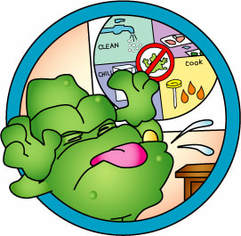 Did you know there is an invisible and scentless enemy ready to strike? His name is Bac (bacteria) and he can make you and your family sick. You may also be surprised to hear Bac and his friends have already invaded your hands, food, kitchen, and utensils. But do not worry! He can be conquered if you don’t take any whisks (risks) if you fight Bac by following the core 4 practices of food handling. Clean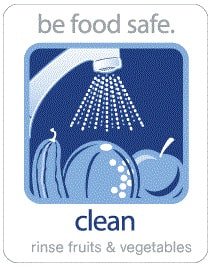 Wash your hands. Thoroughly wash your hands with warm soapy water for at least 20 seconds before and after handling food. It is important to take extra care to washing your hands immediately after handling raw meat. Wash your utensils & work surface. Before starting food preparation sanitize your countertop and ensure all your cutting boards, knives, blender, and other food preparation utensils have been washed and dried. * Check your blender's manual for cleaning instructions. Improper care can cause the seals to deteriorate and harbor bacteria. * Re-clean all surfaces in between different food types, especially when using raw meat. Wash fruits and vegetables. Even if you plan on peeling or cooking them! It’s important to wash produce with an inedible skin like melons, avocados, and oranges because when you cut them open, the knife can transfer bacteria from the outside to the part we eat. Separate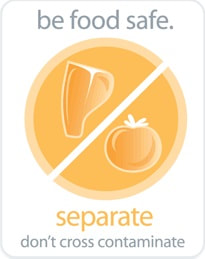 Cross-contamination is how bacteria spreads. improper handling of raw meat, poultry, seafood, and eggs allows Bac and his friends to spread all over your kitchen. Keep raw foods separate. Keeping raw meat, eggs, and vegetables separate is essential in preventing cross-contamination. Use color coded cutting boards. Using one cutting board for fresh produce and a different cutting board for raw meat. To aid in preventing cross-contamination have a designated color for each category, like green for produce and red for meat. Don't reuse surfaces or utensils. Never place cooked food (or food that does not require cooking) on the same surface raw food was once on or use a utensils for cooked food that was used on raw food, unless you thoroughly wash it with warm soapy water first. Need more information? Check out the Get it Straight – it’s Safer to Separate guide by the Partnership for Food Safety Education. Cook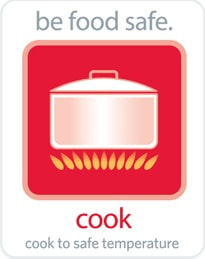 Cooking food thoroughly. Cooking food until it reaches the proper internal temperature kills the bacteria responsible for causing food borne illnesses. Best way to fight Bac. Use a food thermometer to determine your food has reached the proper internal temperature, insert the thermometer into the thickest portion of your cut of meat. Poultry. Cook turkey, chicken, and duck to an internal temperature of 165°F. Ground Meats. Cook ground beef, pork, and lamb to an internal temperature of 160°F. Meat and fish. Cook beef, pork, lamb, and fish to an internal temperature of 145°F. Eggs. Cook eggs to an internal temperature of 160°F. Leftovers. Bring sauces, soups and gravy to a boil when reheating. Heat all other leftovers until they reach 165°F. Chill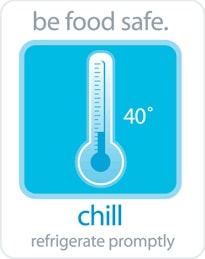 40° or Below. Keep your refrigerator at 40° or colder. Temperatures of 40° or below will slow down the growth of harmful bacteria, which grow QUICKLY in temperatures above 40°. 2-hour Rule. It is important to refrigerate or freeze perishable foods within 2 hours of purchase, use, or preperation. Traveling Cold. The 2-hour rule applies to traveling too. ALWAYS use ice packs and a cooler. Pro tip - a full cooler will keep food colder than a partially empty one. Thaw Safely. Never thaw foods at room temperature, always thaw and cool foods in the fridge, under cold water, or in the microwave. Throw it out. Even in the fridge, food can harbor bacteria. Always follow the reheating guidelines and throw out food spoiled food. The Storage Times Guide will help you determine safe time limits for home refrigerated foods.
0 Comments
Leave a Reply. |
Categories
All
Archives
July 2020
|